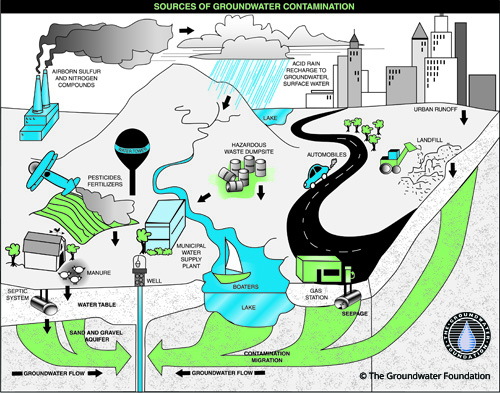View the original article on water-rightgroup.com, the parent company of our WaterCare water softener brand.
Water Quality Awareness – 10 Common Questions Answered
The water crisis in Flint, Michigan has heightened awareness about drinking water contamination nationwide, which could be more widespread than the public realizes.
Lead is far from the only thing that can contaminate a home’s water, and it’s important to know what your family is drinking. This article is not intended to shock and scare people about water quality. However, you should be aware of possible risks and take steps to keep your family safe and healthy.
Here are some answers to frequently asked questions about water quality in the U.S.
1. How Does U.S. Water Quality Compare to the Rest of the World?
We are very fortunate to live in part of the world in which the water quality is much better than other places. That’s why you’re often warned not to drink tap water when you travel to certain foreign countries.
According to the organization WaterAid, more than 650 million people around the world have no access to safe drinking water, and 900 children die every day because of digestive issues from unclean water and poor sanitation. While it’s true that things could be much worse for Americans, we must continue to be vigilant about water quality.
2. Who Regulates the Water We Drink?
The answer to this question depends on which kind of drinking water you’re talking about. There are multiple agencies responsible for regulating water quality in the U.S., and there are some who are more critical about the way it’s handled.
The Environmental Protection Agency (EPA) is in charge of overseeing the water that comes out of your tap. The U.S. Food and Drug Administration (FDA) oversees and regulates the quality of bottled water.
Individual states are responsible for regulating water that is bottled and sold within their borders. Finally, your municipality must make sure it is following federal and state standards regarding water quality.
The EPA does not regulate private wells, and rules for testing differ from state to state. In many cases, it is the homeowner’s responsibility to make sure their well water is safe.
3. What are Water Contaminants?
According to the EPA, the Safe Drinking Water Act (SDWA) defines water contaminants quite broadly. A contaminant can be anything that isn’t a water molecule. So if it’s not H2O, it’s technically a contaminant.
This means that not every contaminant is unsafe to consume. For instance, the dissolved minerals found in 80% of the water in the U.S. pose no health risks. However, minerals like calcium and magnesium can cause hard water problems.
There are many other water contaminants that could lead to health problems. The Water Quality Association (WQA) provides a list of common water contaminants and documents their potential health risks.
The EPA says water contaminants can be:
- Physical– sediment or organic material that changes water’s physical properties.
- Chemical– either naturally-occurring or man-made.
- Biological– microorganisms like bacteria, viruses, and parasites.
- Radiological– chemical elements that emit radiation such as cesium, plutonium, and uranium.
4. What Contaminants Might be Found in Ground Water?
According to GroundWater.org, more than half of the U.S. depends on groundwater, which can be used for municipal water and as the source of water for people with private wells.
Groundwater is an important resource, but it can become easily contaminated and polluted. As the experts at The Groundwater Foundation explain …
“Groundwater contamination occurs when man-made products such as gasoline, oil, road salts and chemicals get into the groundwater and cause it to become unsafe and unfit for human use. Materials from the land’s surface can move through the soil and end up in the groundwater.”
Those materials also include pesticides, fertilizer, and other agricultural runoff like manure, as well as toxic material from hazardous waste sites and leaky landfills.
The graphic below shows the many ways groundwater becomes contaminated and the sources from which those contaminants may come.
5. What Goes Into Municipal Water?
Municipal water is processed at a water treatment facility before it’s delivered to the public, which should make it safe for residents to use.
Municipalities add chemicals to the water when it is treated. One of the most common chemicals used in water treatment is chlorine, which is used as a disinfectant to kill bacteria and other microbes. Sometimes chloramine, a combination of chlorine and ammonia, is also used.
A small, but potential risk of these chemicals comes from byproducts they create in the water when reacting with organic compounds. Those byproducts are trihalomethanes (THMs) and haloacetic acids (HAAs). Some studies indicate THMs and HAAs are linked to increase risk of serious health problems like cancer and heart disease.
However, it’s important to note that water quality would be much worse if municipalities did not use these chemicals to eliminate what could be harmful. The World Health Organization (WHO) says health risks from chlorine are small compared to the dangers of failing to properly disinfect public water.
6. How Does Lead Get in Drinking Water?
Due to the media attention Flint, Michigan, received over its water crisis, a lot of people have questions about lead in public water systems around the U.S.
Lead (as well as copper) typically enters the public supply by leaching into water from corroded fixtures and outdated plumbing. Homes built before 1986 will likely have plumbing with copper pipes using solder that may contain lead.
Lead can cause serious negative health effects, especially in children. The challenge is that it is undetectable by human senses. You can check with your local water authority for information about lead levels, but it’s important to note that the CDC and EPA say there’s no level of lead recognized as safe for consumption.
If you have concerns about the presence of lead in your water, you can have it tested in a state-certified laboratory. You can also read more in our article on lead in drinking water.
7. What if My Water Tastes, Smells, or Looks Strange?
Certain things can affect the flavor, odor, and appearance of your tap water, not all of them are necessarily harmful.
Many people with public water can taste the chlorine, although the most noticeable problems tend to come from private wells. Contaminants like sulfur can impact the smell, while iron will cause discoloration and staining.
The overall amount of total dissolved solids (TDS) in your tap water will definitely affect the taste, smell, and appearance. While many of these issues are not serious concerns, they can certainly be a nuisance. Water filtration systems, including a high-efficiency water softener to reduce hardness, can provide solutions.
You can contact a residential water treatment expert to come to your home and evaluate things like mineral content and TDS. Check out our pictorial about in-home water quality consultations to see what you can expect during a visit from one of our trained experts.
8. Is Bottled Water Safer and Cleaner than Tap Water?’
You might think the safest bet is to purchase bottled water at the store if you want to avoid contaminants in the water you drink. In the past 10 to 15 years, regulations surrounding the quality of bottled water have improved, and bottlers need to back up their claims concerning how their product is marketed. However, bottled water may not be the most cost-effective or environmentally-friendly way to get quality drinking water.
In many cases, bottled water is nothing more than tap water that has usually been treated. This means you could be wasting your money and creating unnecessary waste by drinking bottled water when other filtration options can give you the same quality in your home.
9. How Can I be Sure My Water is Safe to Drink?
The most trustworthy way to find out what’s in your water and its safety is to send samples to a state-certified lab and have it tested.
You can also do some of your own initial research into water quality. For example, the EPA requires your local water utility to provide a Consumer Confidence Report on water quality every year. It should have details on contaminants that may be in your water and the health risks. Use this online tool to find out how to get your report.
The Environmental Working Group (EWG) also provides an online database to help people find reports from their area.
For homeowners with a private well, the Groundwater Foundation recommends having your water tested at a state-certified lab, like Water-Right’s Clean Water Testing, at least once every year.
Water samples for testing should be taken from the source as well as the tap. For bacterial concerns, it’s best for homeowners to contact a local lab because the bacteria could die before an out-of-state lab can test for contamination. For instance, e-coli only lives in water for 48 hours, so testing must be done as soon as possible.
10. Are There Residential Water Treatment Products that Can Help?
If you want complete peace of mind concerning what’s in your water, there are various in-home water filtration options.
One of the best ways to reduce contaminants and get safe water from the tap is to install a reverse osmosis (R.O.) system. Find out more about how R.O. systems work as well as the benefits of reverse osmosis water here on our blog.
Another option for improving water quality is a UV light purification system.
For those who have serious concerns about water quality or potential contamination, you can use our Clean Water Testing service to get the answers you need.




